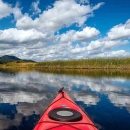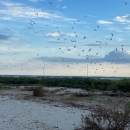What We Do
Wildlife Health
The U.S. Fish and Wildlife Service monitors wildlife health and conducts disease surveillance, response and management. Experts help curb the spread of wildlife disease that threatens wildlife, people and domestic animals. Specialists track the health of birds, ungulates (hooved animals such as bison, deer and elk) and other species; they also monitor harmful algal blooms and animal diseases that could jump to humans. Experts provide training and technical assistance, conduct field investigations of disease and facilitate lab testing. They aid in policy development, research support and veterinary controlled drugs acquisition and use.
Inventory and Monitoring
Researchers assess the status and trends of refuge lands, waters, plants and wildlife, along with their responses to management actions. The Natural Resource Program Center coordinates the design, collection, retention and analysis of this scientific data. Rigorous standards ensure that the Refuge System is a key contributor to the larger body of scientific knowledge.
Human Dimensions
Social scientists help refuge managers factor local attitudes and human perspectives into conservation planning to improve the likelihood of good outcomes.
Air Quality
Experts work to ensure that refuge lands and waters meet the standards of the Clean Air Act and other applicable laws on air quality.
Our Programs
Our Services
Data Repositories
Publicly available national wildlife refuge national wildlife refuge
A national wildlife refuge is typically a contiguous area of land and water managed by the U.S. Fish and Wildlife Service for the conservation and, where appropriate, restoration of fish, wildlife and plant resources and their habitats for the benefit of present and future generations of Americans.
Learn more about national wildlife refuge data sets and documents maintained in ServCat include Comprehensive Conservation Plans, Annual Narrative Reports, Water Resource Inventory and Assessment Reports, and geospatial data. You can also view U.S. Geological Survey data releases in Science Base and the federal government’s Open Data dashboards.
Environmental Conservation Online System (ECOS)
This gateway website includes conservation plans, species reports, fish health survey database, and wildlife and contaminants mapper.






